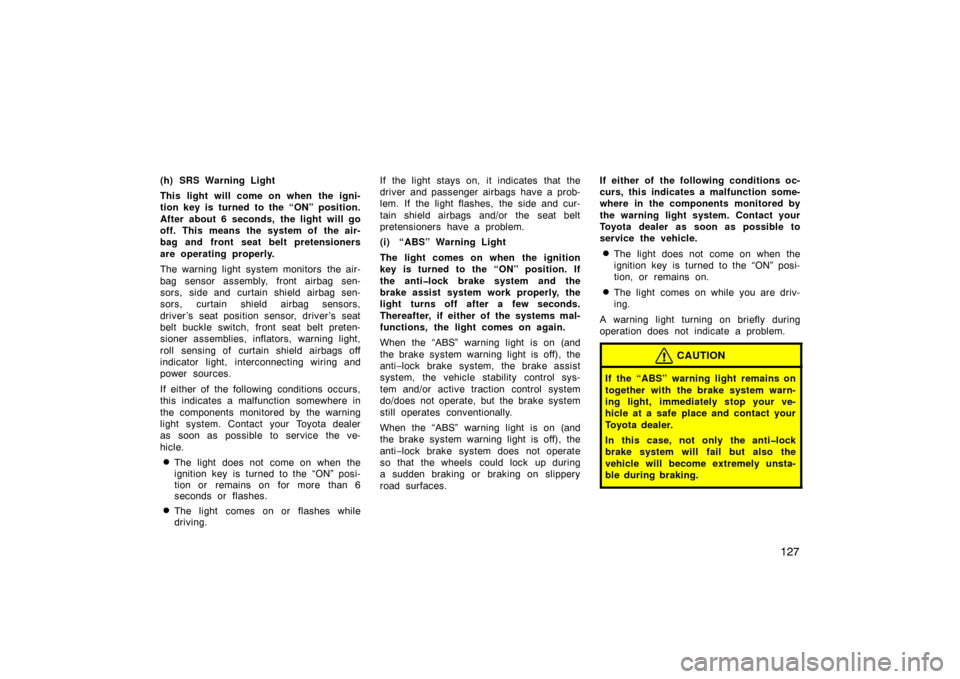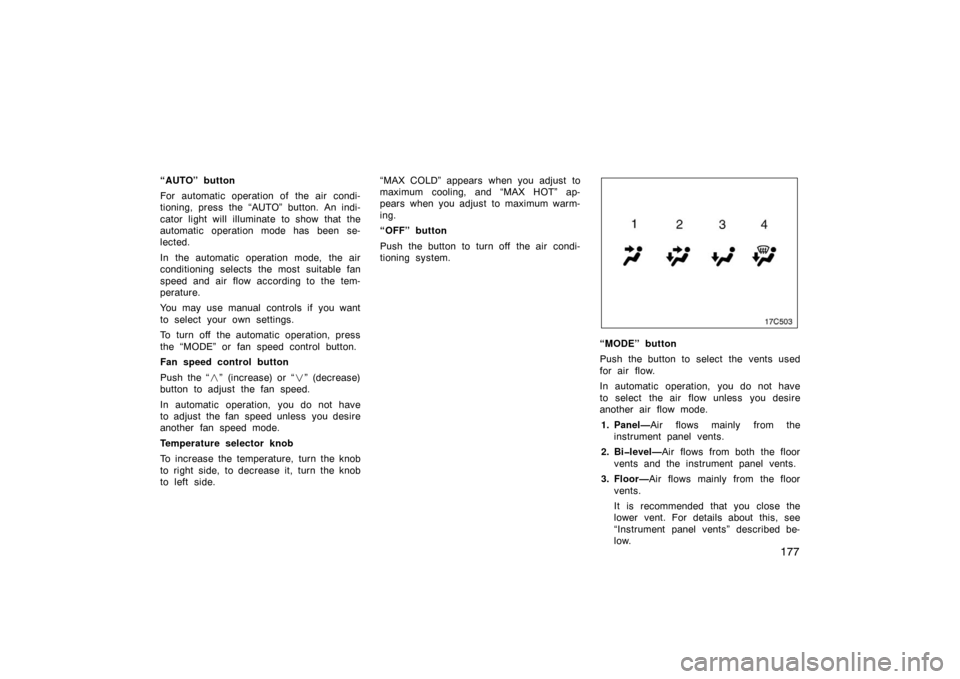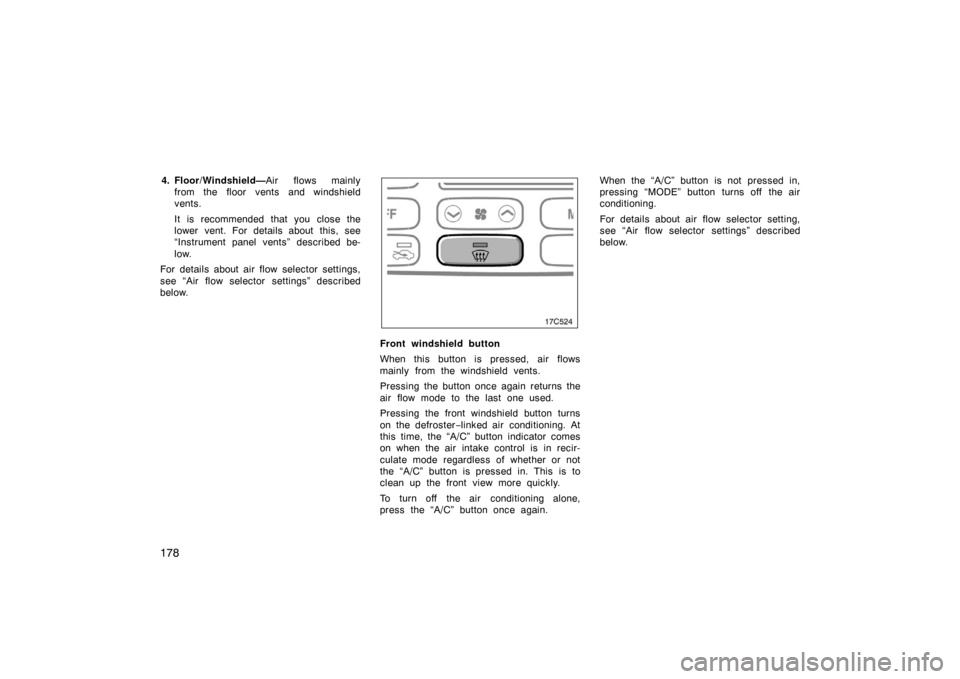Page 137 of 351

127
(h) SRS Warning Light
This light will come on when the igni-
tion key is turned to the “ON” position.
After about 6 seconds, the light will go
off. This means the system of the air-
bag and front seat belt pretensioners
are operating properly.
The warning light system monitors the air-
bag sensor assembly, front airbag sen-
sors, side and curtain shield airbag sen-
sors, curtain shield airbag sensors,
driver ’s seat position sensor, driver ’s seat
belt buckle switch, front seat belt preten-
sioner assemblies, inflators, warning light,
roll sensing of curtain shield airbags off
indicator light, interconnecting wiring and
power sources.
If either of the following conditions occurs,
this indicates a malfunction somewhere in
the components monitored by the warning
light system. Contact your Toyota dealer
as soon as possible to service the ve-
hicle.
�The light does not come on when the
ignition key is turned to the “ON” posi-
tion or remains on for more than 6
seconds or flashes.
�The light comes on or flashes while
driving.If the light stays on, it indicates that the
driver and passenger airbags have a prob-
lem. If the light flashes, the side and cur-
tain shield airbags and/or the seat belt
pretensioners have a problem.
(i) “ABS” Warning Light
The light comes on when the ignition
key is turned to the “ON” position. If
the anti�lock brake system and the
brake assist system work properly, the
light turns off after a few seconds.
Thereafter, if either of the systems mal-
functions, the light comes on again.
When the “ABS” warning light is on (and
the brake system warning light is off), the
anti
−lock brake system, the brake assist
system, the vehicle stability control sys-
tem and/or active traction control system
do/does not operate, but the brake system
still operates conventionally.
When the “ABS” warning light is on (and
the brake system warning light is off), the
anti −lock brake system does not operate
so that the wheels could lock up during
a sudden braking or braking on slippery
road surfaces. If either of the following conditions oc-
curs, this indicates a malfunction some-
where in the components monitored by
the warning light system. Contact your
Toyota dealer as soon as possible to
service the vehicle.
�The light does not come on when the
ignition key is turned to the “ON” posi-
tion, or remains on.
�The light comes on while you are driv-
ing.
A warning light turning on briefly during
operation does not indicate a problem.
CAUTION
If the “ABS” warning light remains on
together with the brake system warn-
ing light, immediately stop your ve-
hicle at a safe place and contact your
Toyota dealer.
In this case, not only the anti�lock
brake system will fail but also the
vehicle will become extremely unsta-
ble during braking.
Page 138 of 351

128
Either of the following conditions may
occur, but do not indicate a malfunc-
tion.
�The light may stay on for about 60
seconds after the ignition key is turned
to “ON” position. It is normal if it turns
off after a while.
�Depressing the brake pedal repeatedly
may turn on the light. It is normal if it
turns off after a few seconds.
(j) Open Door Warning Light
This light remains on until all the side
doors and back door are completely
closed.
(k) Unengaged “Park” Warning Light
This light warns that the transmission
“Park” mechanism is not engaged. If the
four −wheel drive control is in the “N” posi-
tion while the selector lever is in the “P”
position, the transmission will disengage
and the wheels will not lock.
CAUTION
To restore the park function, shift the
four�wheel drive control out of “N”,
or the vehicle can move.
(l) Automatic Transmission Fluid Tem- perature Warning Light
This light warns that the automatic trans-
mission fluid temperature is too high.
If this light comes on while you are driv-
ing, slow down and pull off the road. Stop
the vehicle at a safe place and put the
selector lever in “P” and leave the engine
idling until the light goes off. If the light
goes off, you can start the vehicle again.
If the light does not go off, call a Toyota
dealer or qualified repair shop for assis-
tance.
NOTICE
Continued driving with the warning
light on may damage the automatic
transmission.
(m) Vehicle Stability Control System and Active Traction Control System
Warning Light
This light warns that there is a problem
somewhere in the vehicle stability control
system and/or active traction control sys-
tem.
If the “VSC/TRAC” warning light and “VSC
OFF” indicator light come on, have your
vehicle checked by Toyota dealer as soon
as possible. However, it is no problem
that the “VSC/TRAC” warning light comes
on when the brake actuator temperature
becomes high. (For details, see “Active
traction control system” on page 145.)
The lights will come on with the ignition
key turned to “ON”, and will go off after
a few seconds.
The lights may come on for 60 seconds
after the ignition key is turned to “ON”
position. It is normal if they go out after
a whi l e.
Depressing the brake pedal repeatedly
may turn on the lights. it is normal if they
go out after a few seconds.
Page 178 of 351
168
CARING FOR YOUR COMPACT DISC
PLAYER AND DISCS
�The player is intended for use with 12
cm (4.7 in.) discs only.
�Extremely high temperatures can keep
your compact disc player from working.
On hot days, use the air conditioning
to cool the vehicle interior before you
listen to a disc.
�Bumpy roads or other vibrations may
make your compact disc player skip.
�If moisture gets into your compact disc
player, you may not hear any sound
even though your compact disc player
appears to be working. Remove the
disc from the player and wait until it
dries.
CAUTION
Compact disc players use an invisible
laser beam which could cause hazard-
ous radiation exposure if directed
outside the unit. Be sure to operate
the player correctly.
�Use only compact discs marked as
shown above. The following products
may not be playable on your compact
disc player.
Copy−protected CD
CD− R (CD −Recordable)
CD− RW (CD −Re −writable)
CD− ROMSpecial shaped discs
Z17058
Transparent/tr anslucent discs
Page 185 of 351
175
OPERATION OF INSTRUMENTS AND
CONTROLS
Air conditioning system
Front air conditioning system:Controls 176
. . . . . . . . . . . . . . . . . . . . . . . . . . . . . . . . . . . . .\
. . . . . . . . . . .
Air flow selector settings 180
. . . . . . . . . . . . . . . . . . . . . . . . . . . . . . . . . .
Operating tips 181
. . . . . . . . . . . . . . . . . . . . . . . . . . . . . . . . . . . . \
. . . . . . .
Instrument panel vents 183
. . . . . . . . . . . . . . . . . . . . . . . . . . . . . . . . . . .
Rear air conditioning system:
Controls 184
. . . . . . . . . . . . . . . . . . . . . . . . . . . . . . . . . . . . \
. . . . . . . . . . . .
Air flow selector settings 186
. . . . . . . . . . . . . . . . . . . . . . . . . . . . . . . . . .
For vehicle equipped with Navigation system, please refer to the
separate “ Navigation System Owner’s Manual”.
SECTION 1� 9
Page 186 of 351
176
1. Temperature selector knob
2. “AUTO” button
3. Temperature display
4. Fan speed display
5. Air flow display
6. “MODE” button
7. “A/C” button
8. Front windshield button
9. Fan speed control button
10. Air intake control button
11. “OFF” button
Front air conditioning system—
—Controls
Page 187 of 351

177
“AUTO” button
For automatic operation of the air condi-
tioning, press the “AUTO” button. An indi-
cator light will illuminate to show that the
automatic operation mode has been se-
lected.
In the automatic operation mode, the air
conditioning selects the most suitable fan
speed and air flow according to the tem-
perature.
You may use manual controls if you want
to select your own settings.
To turn off the automatic operation, press
the “MODE” or fan speed control button.
Fan speed control button
Push the “�” (increase) or “ �” (decrease)
button to adjust the fan speed.
In automatic operation, you do not have
to adjust the fan speed unless you desire
another fan speed mode.
Temperature selector knob
To increase the temperature, turn the knob
to right side, to decrease it, turn the knob
to left side. “MAX COLD” appears when you adjust to
maximum cooling, and “MAX HOT” ap-
pears when you adjust to maximum warm-
ing.
“OFF” button
Push the button to turn off the air condi-
tioning system.
“MODE” button
Push the button to select the vents used
for air flow.
In automatic operation, you do not have
to select the air flow unless you desire
another air flow mode.
1. Panel— Air flows mainly from the
instrument panel vents.
2. Bi�level— Air flows from both the floor
vents and the instrument panel vents.
3. Floor— Air flows mainly from the floor
vents.
It is recommended that you close the
lower vent. For details about this, see
“Instrument panel vents” described be-
low.
Page 188 of 351

178
4. Floor/Windshield—Air flows mainly
from the floor vents and windshield
vents.
It is recommended that you close the
lower vent. For details about this, see
“Instrument panel vents” described be-
low.
For details about air flow selector settings,
see “Air flow selector settings” described
below.
Front windshield button
When this button is pressed, air flows
mainly from the windshield vents.
Pressing the button once again returns the
air flow mode to the last one used.
Pressing the front windshield button turns
on the defroster −linked air conditioning. At
this time, the “A/C” button indicator comes
on when the air intake control is in recir-
culate mode regardless of whether or not
the “A/C” button is pressed in. This is to
clean up the front view more quickly.
To turn off the air conditioning alone,
press the “A/C” button once again. When the “A/C” button is not pressed in,
pressing “MODE” button turns off the air
conditioning.
For details about air flow selector setting,
see “Air flow selector settings” described
below.
Page 189 of 351
179
Air intake control button
Press the button to select the air source.
An indicator light will illuminate to show
which air intake mode is being selected.1. Recirculate— Recirculates the air inside
the vehicle.
2. Fresh— Draws outside air into the sys-
tem. “A/C” button
To turn on the air conditioning, press the
“A/C” button. The “A/C” button indicator
will come on. To turn the air conditioning
off, press the button again.
If the “A/C” button indicator flashes, there
is a problem in the air conditioning system
and the air conditioning automatically
shuts off. If this happens, take your ve-
hicle to a Toyota dealer for service.